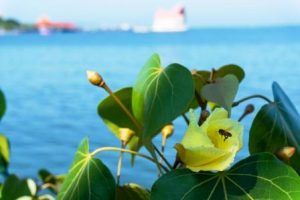Parisa
BOTANICAL NAME: Thespesia populnea Soland ex. Correa
FAMILY: Malvaceae
CLASSICAL CLASSIFICATION:
CHARAKA- PanchValkala, MutraSangrehaniya Mahakashyaya.
SANSKRIT NAME: Gardabhanda, Pareesha, Kapitana, Kamandalu
COMMON NAME:
ENGLISH NAME: False Rosewood
HINDI: Gajadand ,Paraspipal, Porush


HABITAT: Tropical, coastal species that is often found in and around mangroves
BOTANICAL DESCRIPTION:
T. populnea is a medium-sized tree, usually 6-9 m tall with a dense evergreen crown, occasionally to 20 m. The trunk is straight, branchless for up to 3 m, Leaves are alternate, arranged spirally, blade orbicular, deltoid, ovate or oblong, simple and entire; 23 cm long and 15 cm wide, pointed with entire margins, Flowers solitary in leaf axils, bisexual; opening one at a time, on stout 10 cm pedicels.Fruits rounded but flattened, about 3 cm in diameter and 2 cm high, slightly five-ridged, dark grey, hard, woody and dry, with calyx at base.
| RASA | GUNA | VIRYA | VIPAKA | PRABHAVA | DOSHGHNTA |
| Kashaya | Laghu,Snigdha | Sheeta | Katu | – | Pittahar,Kaphaghna |
AYURVEDIC ENERGETICS:
| TASTE | PROPERTY | POTENCY | POST DIGESTIVE EFFECT | EFFECT ACTION | DOSHA ACTION |
| Astringent | Light for digestion, Unuctous in nature | Cold | Undergoes Pungent taste after digestion | – | Pacifies vitiated Pitta & Kapha Dosha |
MAJOR CHEMICAL CONSTITUENTS: Gossypol, Populneol, Calycopterin, Thespesone, Thespone
THERAPEUTIC USES:
- Lepa is advised in wound & skin disorders.
- Decoction is advised in haemmarhoids Bleeding.
- Proven to be effective in Vaginal discharges.
- Prameha, Arsha, Kustha, Yonigada
INDICATIONS:
Shoth Edema, Kushtha Skin Disorders, YoniDosha, Mootra Vyadhi Urinary Disorders, Daha Roga Burning Sensation, Pradar leucorrhea.
USEFUL PART: Stem bark, Root
DOSAGE: Kwath50-100 ml; powder 3-6 g
AYURVEDIC FORMULATION:
Mootra Sangrehniya Kwath.
